The United States one-cent coin, commonly known as a penny, is a unit of currency equaling one one-hundredth of a United States dollar.
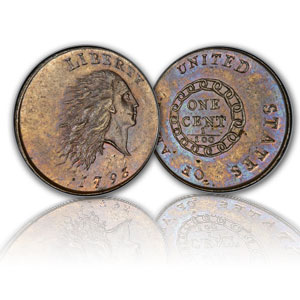
The Chain cent was America's first large cent and the first circulating coin officially produced by the United States Mint. It was struck only during 1793.
The obverse design consisted of a stylized Liberty head with flowing hair. The inscription "LIBERTY" appeared above the portrait, and the date below. The design was rather sparse and empty compared to those that would come later.
The reverse's central design figure, for which the coin is named, is an interlocking chain with 15 links, representing the 15 American states in existence at that time. Both the words "ONE CENT" and the fraction "1/100" appear within the chain. Along the outer edge is inscribed "UNITED STATES OF AMERICA". On the first working die, the engraver failed to allow adequate room for the entire inscription, and it had to be abbreviated to "UNITED STATES OF AMERI.". These early dies were cut by hand, rather than being made from master hubs as is the practice today.
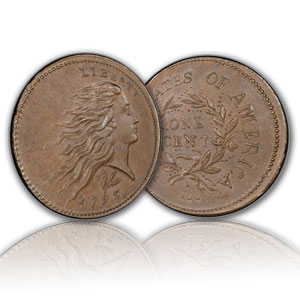
TThe Wreath cent was an American large cent. It was the second design type, following the Chain cent in 1793. It was produced only during that year.
The obverse design consisted of a stylized Liberty head with flowing hair. The inscription "LIBERTY" appeared above the portrait. Below it was a three-leaved sprig and the date. The design of the Liberty head was modified somewhat from that of the Chain cent to address public criticism.
The reverse's central design figure, for which the coin is named, was a wreath. The words "ONE CENT" appeared within the wreath, and the corresponding fraction "1/100" appeared beneath it. Along the outer edge was inscribed "UNITED STATES OF AMERICA". A decorative beaded border was added along the rim.
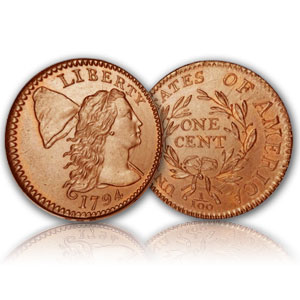
The Liberty Cap Large Cent was a type of large cent struck by the United States Mint from 1793 until 1796, when it was replaced by the Draped Bust large cent.
The Liberty Cap large cent, designed by Joseph Wright, was issued by the Mint from 1793 to 1796. The Mint created this type of cent in an attempt to satisfy the public objections to the Chain cent and Wreath cent. It appears to have been a little more successful than its precedents, as it was continued into 1797, unlike the previous two issues, which were issued for one year only. In 1795, the planchets became too thin for the use of edge lettering on the coins, so coins from late-1795 onward have no edge lettering.
The Liberty Cap half cent was designed not by Wright, however, but by Chief Engraver of the Mint, Robert Scot.
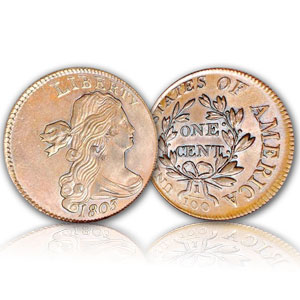
The Draped Bust Large Cent, designed by Robert Scot, is the fourth (and last) large cent type to be struck in the 1700’s.
In fact, it’s the fourth U.S large cent type to appear in the brief time span of 1793 to 1796. The Draped Bust cent replaced the Liberty Cap large cent midway through 1796. This coin features a more feminine, youthful-looking Liberty Bust, her upper chest modesty covered with drapery. On the reverse is the same wreath and “One Cent” inscription used on the Wreath and Liberty Cap cent reverses.
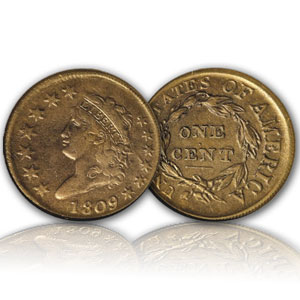
The The Classic Head Large Cent was minted from 1808-1814.
In the year 1808, U.S. citizens, at least those in the larger eastern seaboard cities, were introduced to yet another new type of large cent. This would be the fifth new U.S. large cent type to enter the marketplace in the space of just fifteen years. Like the large cent types that came before, this one featured a bust of Miss Liberty on the obverse, and a wreath with the words “One Cent” within, on the reverse. But this new Miss Liberty was rather startling to some observers. Unlike the graceful, long, flowing-haired Miss Liberty of the earlier 1796 –1807 cent, this Miss Liberty looked a bit heavier, had tightly curled hair and wore a turban with a “Liberty” headband. Not many felt this new large cent design was an improvement over the earlier one (in fact, that sentiment continues to this day). The Miss Liberty on this new type of large cent was promptly dubbed, “The Blowsy Barmaid.”
Today, the “Blowsy Barmaid” cent is known as the Classic Head large cent. It was designed by new mint engraver, John Reich. Actually, this cent didn’t become known as the “Classic Head” cent until the mid-1800’s, when a noted numismatist dubbed it so because of the ancient Greek-like headband worn by Miss Liberty on the face of the coin.
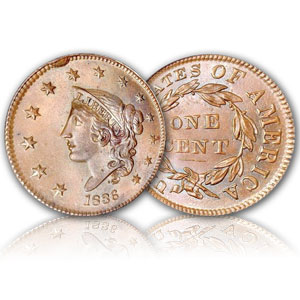
The original Coronet Large Cent, sometimes nicknamed "Matron Head", was a type of cent issued by the United States Mint in Philadelphia from 1816 until 1839.It was one of two similar designs of the Coronet Head Large Cent, the other with a slightly altered profile, produced from 1839 until the end of the production of large cents in 1857. If you’ve come across a virtually uncirculated red-brown Matron Head large cent, chances are it’s dated 1818-20, and comes from a famous U.S. coin hoard find. In fact, most of the uncirculated Matron Head large cents out on the market come from this hoard.
The Matron Head large cent is also known as the Coronet Head large cent. It’s called the Matron Head large cent due to the somewhat portly, masculine, “matronly” (if you will) portrait of Miss Liberty on the obverse. It’s our nation’s sixth large cent type, and continues the tradition of a Miss Liberty bust on the obverse, and “One Cent” within a wreath on the reverse. The Matron Head cent appeared in 1816, following the only year in U.S. history where one-cent coins were not stuck (that would be 1815, of course).
After 1839, the Matron Head large cent was replaced by the Braided Hair large cent. Today, the Matron Head large cent is popular as the first of the two “Middle Date” large cents.
The United States Mint had actually received their shipment of copper planchets from England in late 1815. There had been a longer-than-usual delay, thanks to the War of 1812, where the United States was actually at war with its copper supplier! Consequently, the planchets arrived too late for 1815 large cents to be struck, BUT, the first 1816 Matron Head cents were actually struck in late 1815, though they bore the date of 1816. The quality of copper planchets was clearly superior to those used for the Classic Head large cents of 1808-14. While the Classic Head large cents wore out or become dark and corroded easily, the Matron Head large cents survive today in far better condition, even though like all large cents, they circulated quite a bit.
Interestingly, the ONLY coins struck by the United States Mint in 1816 were Matron Head large cents! A fire had destroyed much of the minting machinery at the Philadelphia mint in January of 1816, mainly the machinery used to strike silver and gold coins. Rather than invest the time and money to replace the destroyed machinery, the mint officials chose instead to coin large cents, as demand for small change for our new nation was great. Besides, foreign silver and gold coins were still plentiful enough to fill the need for the coins of higher denominations.
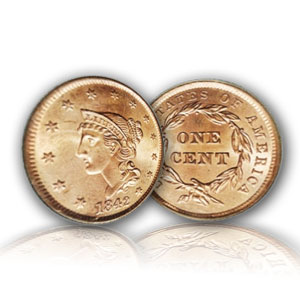
The Braided Hair Large Cent coins, minted from 1839 to 1857, achieved greater uniformity than earlier large cents.
For collectors, the Braided Hair large cent is a very consistent series. Over the course of its issue years of 1839 through 1857, there were no radical design changes, no years were skipped, and in only one year was there a noticeable falloff in mintage numbers. With Braided Hair large cents, you almost don’t have to worry about which ones are the better dates, or which ones are common. Virtually all the dates, save one, are common dates. Butwhile this coin series may contain no great rarities, the Braided Hair large cent will forever go down in history as our nation’s last large cent.
Engraver Christian Gobrecht is responsible for the Braided Hair large cent design. It’s basically similar to the earlier Coronet Head large cent design of 1816-39, but what’s interesting is this: from 1835 through 1839, the large cent was already morphing into the Braided Hair design. The liberty bust on the 1835-39 large cents are clearly different from the standard Coronet Head busts of 1816-34—sharper noses, thinner faces, tighter curls. These 1835-39 Coronet Head large cents (given such sub-type names as “Silly Head” and “Booby Head”) more resemble the Braided Hair large cents than the Coronet Head large cents they are classified under! Even so, when the new 1840 large cent appeared, its liberty bust was even distinctive from the peculiar Coronet Head large cents of 1835-39. So a new classification of large cent was born.
This large cent is a true pioneer-era coin. During its mintage years, California went from being a territory under Mexico, to becoming part of the United States. This cent was in circulation when covered wagons were crossing the plains and deserts, as Americans from the east began seeking new lands to settle out west. To me, a date that really stands out for its historical value is the 1849 large cent. Considering the Gold Rush history behind its date, this large cent represents a great value, especially since it retails no more than any other Braided Hair cent date.
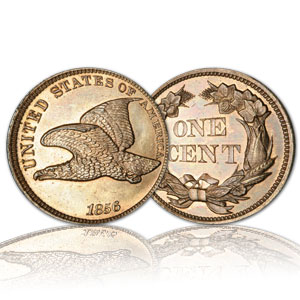
The Flying Eagle Cent was the first small-sized cent coin minted in the US, replacing the earlier large cent.
The Flying Eagle cent came to be because of the unpopularity of the large cent. Yes, large cents are much beloved by collectors today, but by the coin-using public of 1793 to 1857, they were too big, heavy and clumsy for many people’s taste. In fact, the U.S. Treasury came to dislike the large cent over time as well—its face value was only one-cent, yet it was expensive in that it took a large amount of copper to produce. A smaller sized cent was needed.
It was decided to strike a small-sized cent made of 88% copper and 12% nickel. This gave the coin a white-ish appearance when brand new (though that color turned mustard-yellow over time). Because of that white-ish color, the new Flying Eagle cents were often referred to as “White Cents.” The obverse design of the new small cent was actually incorporated from the reverse of an earlier U.S. coin pattern: the 1836-39 Gobrecht pattern dollar.
Despite some 1,000 1856-dated Flying Eagle cent patterns being struck and some slipping into circulation, official authority to strike Flying Eagle cents was not given until February of 1857. In fact, throughout 1856 and into 1857, large cents continued to be struck, so in effect, our nation had two types of one-cent coins circulating side by side in 1856 and 1857. When the TRULY official release of the Flying Eagle cent came about in 1857, the coin was an instant hit. The heavy, cumbersome large cents were quickly set aside by the public in favor of the new, smaller, more easily carried “White Cents.”
There was a huge production of Flying Eagle cents in 1857—17.4 million in fact. In 1858, production was even larger at 24.6 million. Merchants even began complaining about Flying Eagle cents clogging up their tills.
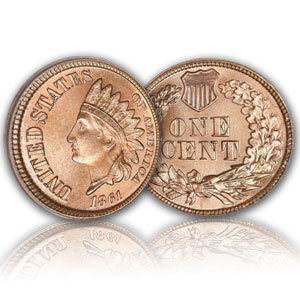
The Indian Head Cent was actually the second type of “small cent” struck by the United States Mint. The Indian Head cent (1859-1909) followed the three-year run of the Flying Eagle cent, struck from 1856 to 1858.
The public really got its first look at the copper-nickel Flying Eagle cents in 1857, since the 1856 output was extremely scant. But in 1857, the new small cents with the flying eagle design hit the streets in droves, and they were a hit with the U.S. public. The new small cents were much handier to use and carry than previous cumbersome large cents.
But though the Flying Eagle cents were popular, they were discontinued after 1858, possibly due to the low relief design which tended to wear down quickly. So in 1859, a new kind of small cent appeared: the Indian Head cent. This cent featured a feminine-looking Miss Liberty wearing an Indian headdress with a “Liberty” ribbon, with a reverse design of a wreath inside which were the words “One Cent.”
From 1859 through 1864, the Indian Head cents were made of copper-nickel. These copper-nickel cents are somewhat thick and have a somewhat mustard-yellow appearance. Despite an output of copper-nickel Indian Head cents in 1864, the composition of the cent was changed that same year to pure copper. Consequently, 1864 Indian Head cents are found in copper-nickel AND pure copper, the only year in the series where cents appear in two different forms of metal composition.
The Indian Head cent would maintain its copper composition, weight, and size for the duration of its run through 1909.
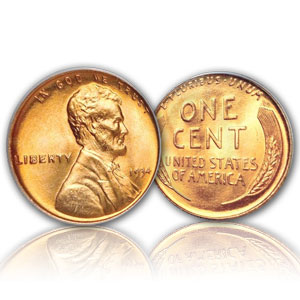
The Lincoln Head Penny is the current one cent coin of the United States. It was adopted in 1909, replacing the Indian head cent.
The year was 1909. Theodore Roosevelt was the U.S. President of a nation with 46 states. A woman could be arrested for smoking in public. There were only 10 miles of paved roads. There were more lynchings than automobile fatalities. The average worker made about $13 a week, and the life expectancy for a man was slightly over 46 years, 47 for a woman. When Americans talked about the “last war,” they were referring to the Spanish-American War. Into this landscape entered a brand-new one-cent coin. At the beginning of 1909, there were still Indian Head cents being struck, but later, a new cent was introduced: the Lincoln cent.
The obverse of the new 1909 Lincoln cent looks basically like the obverse of the Lincoln cent today, with some minor facial and hair variations. The reverse, however, was a simple design showing two wheat ears flanking the words, “ONE CENT” within them. In that first year of 1909, the new Lincoln cent was struck at the Philadelphia and the San Francisco mints, as the Denver mint had not yet begun operations. The 1909 Lincoln cent shared space in commerce with the Liberty Head nickel, the Barber dime, Barber Quarter, Barber Half dollar and Morgan dollar (though the Morgan dollar was taking a breather from 1905-1920).
Although the Lincoln cent has only undergone one major design change since 1909 (the wheat-ear reverse design of 1909-58 was changed to the Lincoln memorial design in 1959), there have been a few composition changes over the years. From 1909 to 1942, the Lincoln cent was struck in bronze. Due to the U.S. being embroiled in World War II, the 1943 cent was made of zinc-coated steel, giving it a peculiar-looking blue appearance. In 1944, the “brown” Lincoln cent returned.
In January 1909, the Mint engaged Brenner to design a cent depicting the late president, Abraham Lincoln, 1909 being the centennial year of his birth. Brenner's design was eventually approved, and the new coins were issued to great public interest on August 2, 1909.
Brenner's initials (VDB), on the reverse at its base, were deemed too prominent once the coins were issued, and were removed within days of the release. The initials were restored, this time smaller, on Lincoln's shoulder, in 1918.
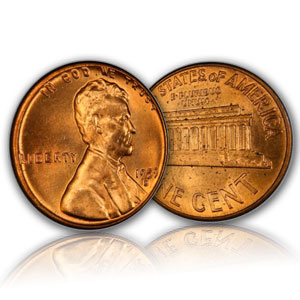
Brenner's reverse was replaced in 1959 by a depiction of the Lincoln Memorial designed by Frank Gasparro, for the sesquicentennial of his birth year. The Lincoln Memorial reverse was itself replaced in 2009 by commemorative designs marking the bicentennial of Lincoln's birth. Beginning in 2010, Bass's shield design was coined. Originally struck in 95% copper, the penny coin was changed for one year to steel in 1943 as copper was needed to aid in the war effort. The mint then reverted to 95% copper until 1982, when inflation made copper too expensive and the composition was changed to zinc with an outer copper layer.